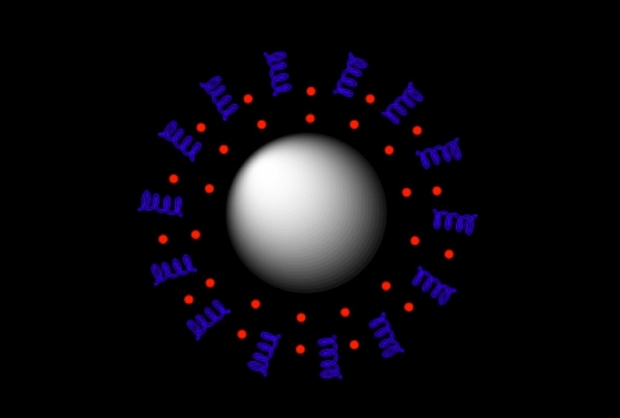创新背景
该方法在老鼠身上进行了测试,使用聚焦超声使药物分子在注射到血液中的纳米颗粒“笼子”中松动。
创新过程
在一项原理证明的研究中,研究人员表明,一种具有药理活性的速效药物可以从这些笼子中释放出来,通过聚焦超声光束照射到大鼠大脑的小区域。这种药物立即起作用,减少了目标区域的神经活动——但只有在超声设备活跃且超声强度超过一定阈值时才有效。通过调整光束的强度和持续时间,研究人员可以微调神经抑制。

虽然这项研究中使用的药物是异丙酚,一种通常用于手术的麻醉剂,但在原则上,同样的方法也适用于许多药理作用和精神病学应用差异很大的药物,甚至适用于一些用于抗癌的化疗药物。
通过提高超声强度和监测全脑代谢活动,研究人员还可以观察药物对接收目标区域输入的远下游脑区域的次级影响。通过这种方式,研究人员能够无创性地绘制出活体大脑中不同电路之间的连接。
一种类似的被称为光遗传学的技术,由卡尔·戴瑟罗斯(Karl Deisseroth)博士首创,他是斯坦福大学生物工程、精神病学和行为科学的教授,十年前在他的指导下,艾兰完成了他的博士工作,使用侵入性基因传递使特定类别的神经细胞容易受到精确的实验操作的影响。Airan的方法采用无创药理学方法来实现类似的神经活动控制。
高强度聚焦超声通常用于身体组织成像的低强度无害,它被批准用于消融或故意破坏某些组织,包括大脑中央结构丘脑的一部分,以治疗特发性震颤。
在这项新的研究中,研究人员调低了超声设备的刻度盘。这些实验中使用的超声强度约为临床消融过程中使用强度的十分之一至百分之一。在这些实验中,超声波是通过一系列短的断奏脉冲传递的,脉冲之间有一段休息时间,这让目标脑组织有足够的时间在脉冲之间冷却。多次暴露在实验方案下的大鼠没有显示出组织损伤的证据。

多年来,Airan一直在完善这些纳米颗粒,它们是生物兼容的、生物可降解的、充满液体的球体,平均直径为400纳米(约1英寸的1500万分之1)。它们的表面由共聚物基质组成,所选择的药物被封装在其中。大约有300万个药物分子点缀在这些纳米颗粒的表面。
每个纳米颗粒都包含一种叫做全氟碳的物质滴。在适当频率的超声波的冲击下,这些液体芯开始摇晃和膨胀,直到覆盖表面的共聚物基质破裂,使被困的药物分子释放出来。
创新价值
这项重要的工作证实了超声波药物解锁似乎具有通过靶向药物应用来调整大脑活动所需的精度。这项新技术可以用来测试光遗传学灵感的想法,最初来自于啮齿类动物的研究,在大型动物中,也许很快就会用于临床试验。
创新关键点
在这项新的研究中,研究人员调低了超声设备的刻度盘。这些实验中使用的超声强度约为临床消融过程中使用强度的十分之一至百分之一。在这些实验中,超声波是通过一系列短的断奏脉冲传递的,脉冲之间有一段休息时间,这让目标脑组织有足够的时间在脉冲之间冷却。
Ultrasound is used to release drugs in the brain
In a proof-of-principle study, the researchers showed that a pharmacologically active, fast-acting drug could be released from these cages by shining a focused ultrasound beam onto small areas of the rat brain. The drug worked immediately, reducing neural activity in the targeted area-but only when the ultrasound equipment was active and the intensity of the ultrasound exceeded a certain threshold. By adjusting the intensity and duration of the beam, the researchers could fine tune neural inhibition.
Although the drug used in this study was propofol, an anesthetic commonly used in surgery, in principle the same approach could be applied to many drugs with widely varying pharmacological effects and psychiatric applications, and even to some chemotherapy drugs used to fight cancer.
By increasing ultrasound intensity and monitoring metabolic activity throughout the brain, researchers can also look at secondary effects of the drug on brain regions far downstream that receive input from the target region. In this way, the researchers were able to noninvasively map the connections between different circuits in the living brain.
A similar technique, known as optogenetics, was pioneered by Dr. Karl Deisseroth, a professor of bioengineering, psychiatry and behavioral sciences at Stanford under whose supervision Aylan completed his doctoral work a decade ago, The use of invasive gene delivery leaves specific classes of nerve cells vulnerable to precise experimental manipulation. Airan's approach uses a noninvasive pharmacological approach to achieve similar control of neural activity.
High-intensity focused ultrasound is typically used for low-intensity, harmless imaging of body tissues, and it is approved to ablate or deliberately destroy certain tissues, including part of the thalamus, a central structure of the brain, to treat essential tremor.
In the new study, the researchers turned down the dial on the ultrasound device. The intensity of ultrasound used in these experiments is about one-tenth to one-hundredth of that used in clinical ablation procedures. In these experiments, ultrasound was delivered through a series of short staccato pulses with a rest period between pulses, which gave the target brain tissue enough time to cool in between pulses. Rats repeatedly exposed to the experimental protocol showed no evidence of tissue damage.
Airan has spent years perfecting these nanoparticles, which are biocompatible, biodegradable, fluid-filled spheres with an average diameter of 400 nanometers (about 1 15 millionth of an inch). Their surface consists of a copolymer matrix in which the drug of choice is encapsulated. About three million drug molecules dot the surface of these nanoparticles.
Each nanoparticle contains a drop of a substance called perfluorocarbon. Upon impact with the appropriate frequency of ultrasonic waves, these liquid cores begin to shake and expand until the copolymer matrix covering the surface cracks, freeing the trapped drug molecules.
智能推荐
AI+医学影像 | 利用AI检测多发性硬化症患者的脑成像变化
2022-08-08伦敦大学学院和伦敦国王学院的研究人员开发了一种新的基于人工智能的方法,用于检测大脑对多发性硬化症(MS)治疗的反应。
涉及学科涉及领域研究方向利用微流体和磁铁分离出嗜碱性粒细胞
2022-08-15斯坦福大学的研究人员使用微流体和磁铁迅速分离出罕见的、过敏原反应性白细胞,称为嗜碱性粒细胞。这种新设备可以帮助彻底改变目前缓慢而痛苦的皮肤测试和口服食物的过敏诊断过程。
涉及学科涉及领域研究方向“多肽纳米毯”为防治肿瘤转移提供新策略
2022-07-01该研究设计构建了转移前微环境响应性后组装多肽FR17,并证明FR17在体后组装形成的“多肽纳米毯”通过抑制成纤维细胞激活调控转移前微环境的形成,实现了肿瘤转移的有效防治,为抗肿瘤转移多肽药物递送提供了一种自身具有微环境调控能力的响应性后组装功能性载体平台。
涉及学科涉及领域研究方向肿瘤治疗学创新 | 新型声控大肠杆菌可寻找并破坏癌细胞
2022-10-12研究人员开发出一种特殊的细菌大肠杆菌(大肠杆菌),当注射到患者体内时,它会寻找并渗透癌性肿瘤。一旦细菌到达目的地,就可以触发它们以产生具有超声波脉冲的抗癌药物。
涉及学科涉及领域研究方向